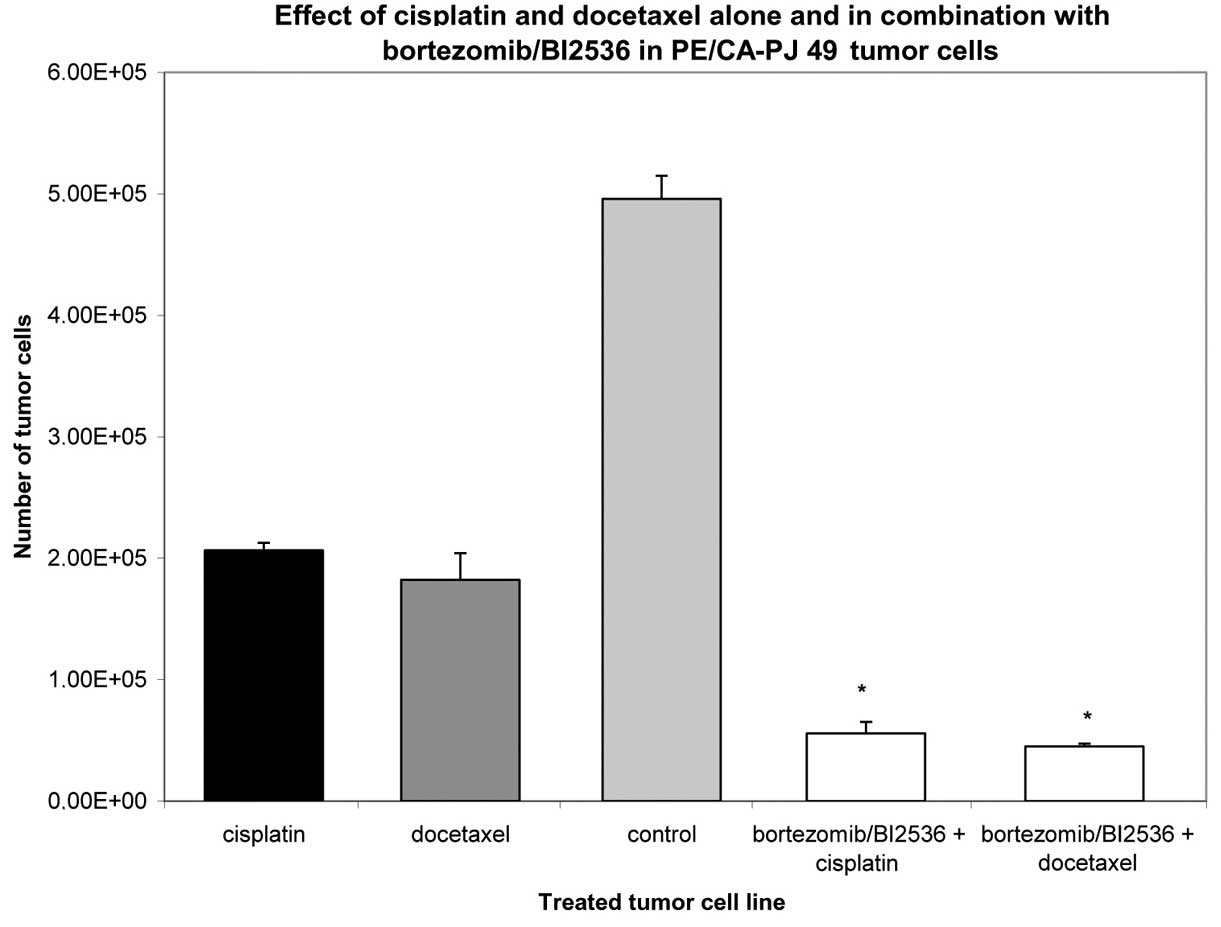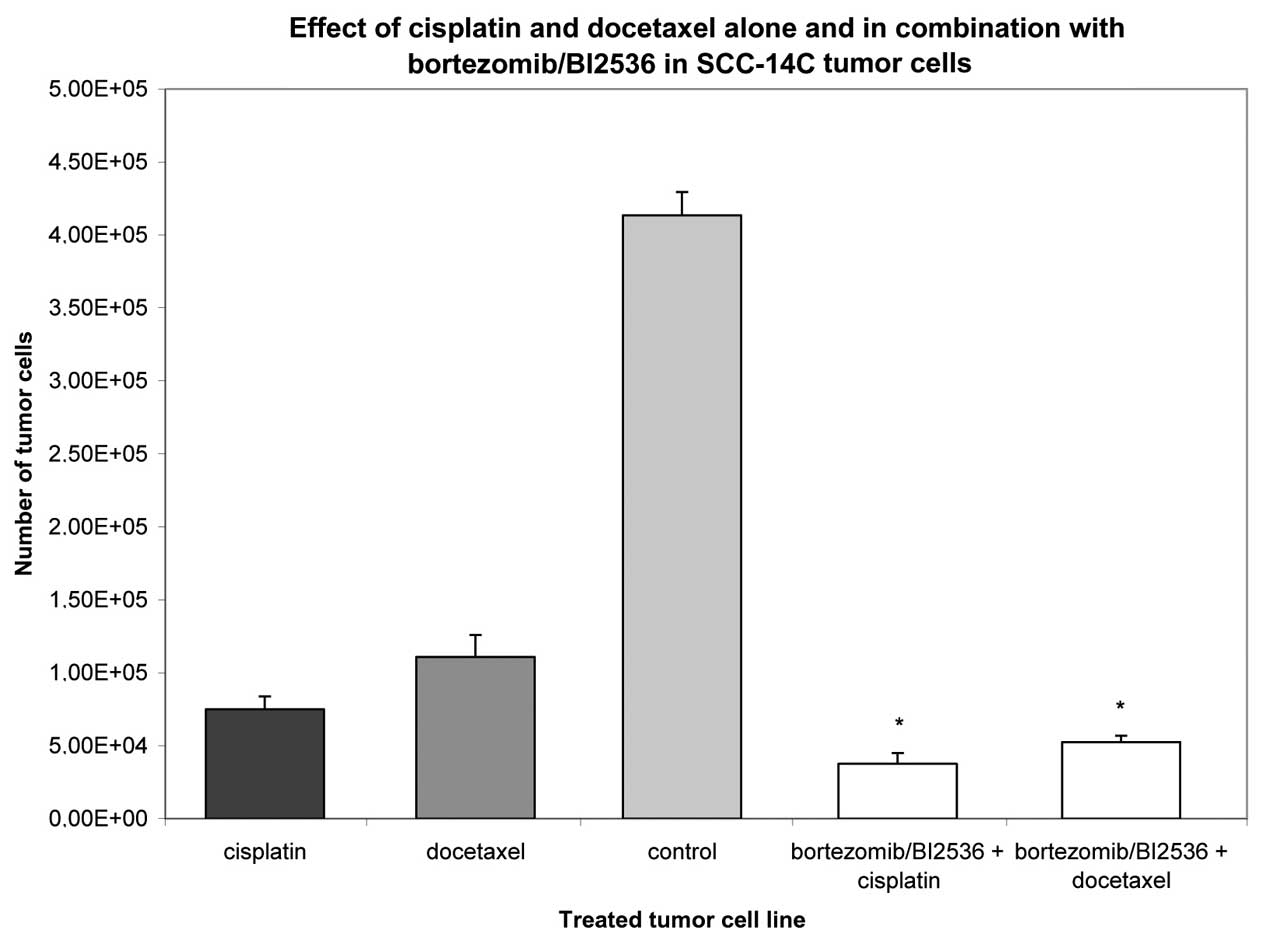Introduction
Squamous cell carcinoma of the head and neck (SCCHN)
is among the 10 most common types of cancer worldwide and arises
from the surface epithelium of the upper-aerodigestive tract,
including the oral cavity (1). As
well as extensive tobacco and alcohol abuse, various
epidemiological studies have revealed HPV-infection to be an
independent risk factor in the development of SCCHN (2–4). The
advent of chemotherapeutical drug regimes to treat head and neck
cancer in the early 1980s changed a number of therapeutical
paradigms. Previously, most patients with head and neck cancer of a
higher tumor stage were treated either by surgery and postoperative
radiotherapy or by definitive radiotherapy. In more recent years,
induction chemotherapy became a matter of interest as a treatment
option in modern oncology (5).
Although remission rates were often associated with severe
side-effects, including nephrotoxicity and cardiovascular
complications, cisplatin and docetaxel remain the most commonly
used cytotoxic agents in the treatment of patients with SCCHN
(6–8). However, these serious side-effects
often require a reduction in dose or even discontinuation of
chemotherapy. Although therapeutic treatment options have become
more refined in recent decades, the prognosis of SCCHN remains
poor. Therefore, one of the great challenges currently is to
identify new, well-tolerated drug regimes which do not compromise
the antitumor effect. Previously, several studies demonstrated that
the proteasome inhibitor bortezomib was a prime candidate for drug
development, not only in hematological malignancies, but also in
solid cancers, including SCCHN (9–11).
Other studies have shown further that bortezomib may be utilized to
overcome cisplatin resistance in squamous cell carcinoma (12). In a previous systemic in
vitro investigation, we showed that the polo-like-kinase-1
(PLK1) inhibitor BI2536 had a marked antitumor effect in a large
number of SCCHN cell lines (Wagenblast et al, unpublished
data).
In order to address the need of developing new
cancer treatment regimes, the aim of the present study was to
evaluate the antitumor effects of a combination of the small
molecules bortezomib and BI2536 with the conventional
chemotherapeutic drugs cisplatin and docetaxel in nine tumor cell
lines of squamous carcinoma origin.
Materials and methods
Nine squamous carcinoma cell lines, most of head and
neck origin, were tested in the present study. A-431 cells were
obtained from ATCC (American Type Culture Collection, Manassas, VA,
USA). The PE/CA-PJ 15, PE/CA-PJ 41, PE/CA-PJ 49 and PE/CA-PJ 34
cell lines were obtained from ECACC (European Collection of Cell
Cultures, Salisbury, UK) and Cal-27 and Kyse-140 cells from DSMZ
GmbH (Braunschweig, Germany). CLS-354 and UM-SCC-14 C cells were
obtained from Cell Lines Service (CLS; Eppelheim, Germany). A
fibroblast cell line (human praeputium), used as a control cell
line, was a gift from the Department of Dermatology, University
Hospital (Frankfurt am Main, Germany). Bortezomib
(Velcade®) was supplied by Millenium Pharmaceuticals
Inc. (Cambridge, MA, USA) and Johnson & Johnson Pharmaceuticals
(Raritan, NJ, USA). BI2536 was provided by Boehringer Ingelheim
GmbH (Vienna, Austria). Squamous carcinoma cell lines were
cultivated according to the supplier’s instructions with
antibiotics at 37°C in the cell type-specific Quantum 263 medium
with L-glutamine (PAA Laboratories GmbH, Pasching, Austria). Cells
were seeded in 96-multiwell plates (1x105 cells/well)
and, following incubation for 24 h, the cells were treated with
cisplatin or docetaxel alone or in combination with bortezomib and
BI2536 for 24, 48 and 76 h, respectively. In the experiments,
bortezomib, BI2536, cisplatin and docetaxel were used in each cell
line at a fixed, cell line-specific concentration that had produced
maximum growth inhibition in previous systematic investigations in
our laboratory. The concentration for bortezomib ranged from 1.25
to 5 μM. The concentration for all cell lines investigated
was 2.5 nmol/l for BI2536, showing maximal growth inhibition in our
previous dose escalation studies. Dosage of cisplatin ranged from
0.19 to 3.125 μM and docetaxel from 2.5 to 15 nM (Table I). The number of cells was
determined by counting cells in a Rosenthal chamber at 24, 48 and
72 h after treatment. Apoptosis was detected by microscopic
cytohistology as well as using the Human Apoptosis Array kit
(R&D Systems, Abingdon, UK) as described previously (13,14).
 | Table ICell line-specific drug
concentrations of bortezomib, BI2536, cisplatin and docetaxel. |
Table I
Cell line-specific drug
concentrations of bortezomib, BI2536, cisplatin and docetaxel.
| Tumor cell
line | Concentration
|
|---|
| Cisplatin
(μM) | Docetaxel (nM) | Bortezomib
(μM) | BI2536 (nM) |
|---|
| PE/CA-PJ 15 | 1.56 | 2.5 | 2.50 | 2.50 |
| PE/CA-PJ 34 | 1.56 | 2.5 | 5.00 | 2.50 |
| PE/CA-PJ 41 | 0.19 | 5.0 | 2.50 | 2.50 |
| PE/CA-PJ 49 | 1.56 | 15.0 | 1.25 | 2.50 |
| CLS 354 | 1.56 | 10.0 | 1.25 | 2.50 |
| UM-SCC-14 C | 1.56 | 10.0 | 2.50 | 2.50 |
| Cal-27 | 0.39 | 15.0 | 2.50 | 2.50 |
| Kyse-140 | 3.125 | 5.0 | 2.50 | 2.50 |
| A-431 | 0.78 | 15.0 | 2.50 | 2.50 |
Each experiment was performed in triplicate. For
statistical analysis, a Wilcoxon test for matched pairs (dependent
samples) was performed using SPSS 19.0 software for Windows.
P<0.05 was considered to indicate a statistically significant
result.
Results
Nine squamous carcinoma cell lines, most of head and
neck origin, were tested in this study. Following incubation for 24
h, the cells were treated with cisplatin and docetaxel alone or
with a combination of bortezomib and BI2536 for 24, 48 and 76 h.
Compared with the untreated control groups, the proteasome
inhibitor bortezomib, the PLK-1-inhibitor BI2536, cisplatin and
docetaxel had a significant antiproliferative and apoptotic effect
when used as single agent treatments in all nine tumor cell lines
(P=0.008). The combination of bortezomib/BI2536 and cisplatin
showed a significantly higher antiproliferative activity compared
with cisplatin alone (P=0.008). The same phenomenon was observed in
the combination of bortezomib/BI2536 with docetaxel compared with
docetaxel monotherapy (P=0.021; Figs.
1 and 2). Apoptosis was
detected by microscopic cytohistology as well as using the Human
Apoptosis Array kit (R&D Systems), detecting pro caspase 3 as a
typical molecular apoptosis marker.
The combination of the conventional chemotherapeutic
drugs cisplatin and docetaxel with small molecules in this in
vitro examination significantly enhanced the antitumor activity
of these agents.
Discussion
Various molecularly targeted approaches have been
investigated in SCCHN patients in the search of improved
selectivity and toxicity. Targets that are worth considering
include growth factor receptors, signal transduction proteins,
kinases, such as PLK1, and proteins involved in the degradation of
kinases, such as the proteasome (15,16).
Previous studies have demonstrated the marked growth inhibitory and
apoptotic effects of bortezomib, a small molecular weight
reversible inhibitor of the intracellular 26S proteasome, in SCCHN
(10,17). Bortezomib acts primarily by
inhibition of the NFκB signaling pathway, although the complete
molecular mechanism leading to the antitumor action of this
proteasome inhibitor remains unidentified (18,19).
BI2536 is a further selective and potent small molecule that
inhibits PLK1, which is a key player in processes such as cell
division and checkpoint regulation in mitosis (20). Approximately 80% of human tumors
express high levels of PLK-1 transcripts, which are correlated with
poor prognosis (20–23). PLK inhibitors, such as BI2536 and
BI6727, interfere with several stages of mitosis, including spindle
formation and chromosome separation, thus inducing a mitotic chaos
leading to a disruption of cell cycle progression. In the present
study, we showed the enhanced antitumor effect of a combination of
two small molecules which affect different signaling pathways. The
drug combination of bortezomib/BI2536 with cisplatin showed a
significantly higher antiproliferative activity compared with
cisplatin alone (P<0.008). The same phenomenon was observed in
the combination of bortezomib/BI2536 with docetaxel compared with
docetaxel monotherapy (P=0.021). In summary, the results of our
systemic in vitro experiments have demonstrated the growth
inhibitory and proapoptotic effect of a combination regime
consisting of the two small molecules bortezomib/BI2536 in
combination with conventional chemotherapeutic drugs, cisplatin and
docetaxel, in SCCHN cell lines for the first time.
With regard to the combination of two small
molecules, bortezomib/BI2536, enhancing the antiproliferative
effect of both cytotoxic agents, cisplatin and docetaxel, it
appears to be possible to reduce the doses of the conventional
drugs and thus to reduce the severe side-effects of these regimes
in the future.
Acknowledgements
The authors thank Boehringer Ingelheim
GmbH for providing BI2536. The authors thank Erika Weith for
excellent technical support.
References
|
1.
|
H MehannaV PaleriCM WestC NuttingHead and
neck cancer - Part 1: Epidemiology, presentation, and
preventionBMJ341c4684201010.1136/bmj.c468420855405
|
|
2.
|
G D’SouzaAR KreimerR ViscidiM PawlitaC
FakhryWM KochCase-control study of human papillomavirus and
oropharyngeal cancerN Engl J Med35619441956200717494927
|
|
3.
|
M PantelO Guntinas-LichiusLaryngeal
carcinoma: epidemiology, risk factors and survivalHNO6032402012(In
German)
|
|
4.
|
C WittekindtS WagnerJP
KlussmannHPV-associated head and neck cancer. The basics of
molecular and translational researchHNO598858922011(In German)
|
|
5.
|
JL LefebvreG AndryD ChevalierB LuboinskiL
ColletteL Traissacfor the EORTC Head and Neck Cancer GroupLaryngeal
preservation with induction chemotherapy for hypopharyngeal
squamous cell carcinoma: 10-year results of EORTC trial 24891Ann
OncolApr62012(Epub ahead of print)
|
|
6.
|
AA ForastiereT LeongE RowinskyBA MurphyDR
VlockRC DeContiGL AdamsPhase III comparison of high-dose paclitaxel
+ cisplatin + granulocyte colony-stimulating factor versus low-dose
paclitaxel + cisplatin in advanced head and neck cancer: Eastern
Cooperative Oncology Group Study E1393J Clin
Oncol19108810952001
|
|
7.
|
G RameshWB ReevesTNF-alpha mediates
chemokine and cytokine expression and renal injury in cisplatin
nephrotoxicityJ Clin
Invest110835842200210.1172/JCI20021560612235115
|
|
8.
|
N PablaZ DongCisplatin nephrotoxicity:
mechanisms and renoprotective strategiesKidney
Int739941007200810.1038/sj.ki.500278618272962
|
|
9.
|
A FribleyQ ZengCY WangProteasome inhibitor
PS-341 induces apoptosis through induction of endoplasmic reticulum
stress-reactive oxygen species in head and neck squamous cell
carcinoma cellsMol Cell
Biol2496959704200410.1128/MCB.24.22.9695-9704.2004
|
|
10.
|
J WagenblastM HambekM BaghiW GstöttnerK
StrebhardtH AckermannR KnechtAntiproliferative activity of
bortezomib alone and in combination with cisplatin or docetaxel in
head and neck squamous cell carcinoma cell linesJ Cancer Res Clin
Oncol134323330200810.1007/s00432-007-0287-917701215
|
|
11.
|
JB SunwooZ ChenG DongN YehC Crowl
BancroftE SausvilleNovel proteasome inhibitor PS-341 inhibits
activation of nuclear factor-kappa B, cell survival, tumor growth,
and angiogenesis in squamous cell carcinomaClin Cancer
Res714191428200111350913
|
|
12.
|
AM FribleyB EvenchikQ ZengBK ParkJY GuanH
ZhangProteasome inhibitor PS-341 induces apoptosis in
cisplatin-resistant squamous cell carcinoma cells by induction of
NoxaJ Biol Chem2813144031447200610.1074/jbc.M60435620016928686
|
|
13.
|
D DattaP BanerjeeM GasserAM Waaga-GasserS
PalCXCR3-B can mediate growth-inhibitory signals in human renal
cancer cells by down-regulating the expression of heme oxygenase-1J
Biol Chem2853684236848201010.1074/jbc.M110.17032420855888
|
|
14.
|
RB RayA RaychoudhuriR SteeleP
NerurkarBitter melon (Momordica charantia) extract inhibits
breast cancer cell proliferation by modulating cell cycle
regulatory genes and promotes apoptosisCancer
Res7019251931201020179194
|
|
15.
|
J WagenblastM BaghiC ArnoldnerS BisdasW
GstöttnerH AckermannEffect of bortezomib and cetuximab in
EGF-stimulated HNSCCAnticancer Res2822392243200818751401
|
|
16.
|
CW ReuterMA MorganA EckardtTargeting
EGF-receptor-signalling in squamous cell carcinomas of the head and
neckBr J Cancer96408416200710.1038/sj.bjc.660356617224925
|
|
17.
|
J WagenblastM BaghiC ArnoldnerS BisdasW
GstöttnerH AckermannCetuximab enhances the efficacy of bortezomib
in squamous cell carcinoma cell linesJ Cancer Res Clin
Oncol135387393200910.1007/s00432-008-0477-018830627
|
|
18.
|
A MilanoRV IaffaioliF CaponigroThe
proteasome: a worthwhile target for the treatment of solid
tumours?Eur J
Cancer4311251133200710.1016/j.ejca.2007.01.03817379504
|
|
19.
|
J AdamsThe development of proteasome
inhibitors as anti-cancer drugsCancer
Cell5417421200410.1016/S1535-6108(04)00120-5
|
|
20.
|
P SchoffskiJY BlayJ De GreveE BrainJP
MachielsJC SoriaMulticentric parallel phase II trial of the
polo-like kinase 1 inhibitor BI 2536 in patients with advanced head
and neck cancer, breast cancer, ovarian cancer, soft tissue sarcoma
and melanoma. The first protocol of the European Organization for
Research and Treatment of Cancer (EORTC) Network Of Core Institutes
(NOCI)Eur J Cancer46220622152010
|
|
21.
|
TL SchmitN AhmadRegulation of mitosis via
mitotic kinases: new opportunities for cancer managementMol Cancer
Ther619201931200710.1158/1535-7163.MCT-06-078117620424
|
|
22.
|
K StrebhardtA UllrichTargeting polo-like
kinase 1 for cancer therapyNat Rev
Cancer6321330200610.1038/nrc184116557283
|
|
23.
|
R KnechtR ElezM OechlerC SolbachC von
IlbergK StrebhardtPrognostic significance of polo-like kinase (PLK)
expression in squamous cell carcinomas of the head and neckCancer
Res5927942797199910383133
|
















